
Definitions of culture, norms, sanctions, values, and the role of language. Also includes a discussion of the elements of the Sapir Whorf Hypothesis.
- Subject:
- Social Science
- Sociology
- Material Type:
- Lesson
- Author:
- Kris Campea
- Date Added:
- 11/06/2023

Definitions of culture, norms, sanctions, values, and the role of language. Also includes a discussion of the elements of the Sapir Whorf Hypothesis.

The United States Census Bureau has a long history of conducting research to improve questions and data on race and ethnicity. Since the first census in 1790, the Census Bureau has collected information on race/ethnicity and the census form has reflected changes in society and shifts that have occurred in the way the Census Bureau classifies race and ethnicity. Since the 1970s, the Census Bureau has conducted content tests to research and improve the design and function of different questions, including questions on race and ethnicity. Today, the Census Bureau collects race and ethnic data following U.S. Office of Management and Budget (OMB) guidelines, and these data are based upon self-identification.

Video lesson covering the concepts of absolute and relative poverty.
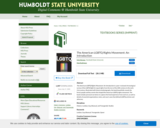
The American LGBTQ Rights Movement: An Introduction is a peer-reviewed chronological survey of the LGBTQ fight for equal rights from the turn of the 20th century to the early 21st century. Illustrated with historical photographs, the book beautifully reveals the heroic people and key events that shaped the American LGBTQ rights movement. The book includes personal narratives to capture the lived experience from each era, as well as details of essential organizations, texts, and court cases that defined LGBTQ activism and advocacy.
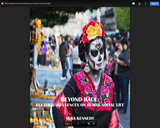
The book is supported by discussion of relevant theory and research in cultural sociology.Beyond Race: Cultural Influences on Human Social Life has stressed learner-centered teaching with the instructor taking on the role of a facilitator of learning. As such, it is expected the instructor will serve as the mediator between the content of this book and learners’ understanding of material on multiple and higher levels. This book does not offer a set of rules in teaching cultural sociology, but rather suggests content and applications to consider and modify as needed by the ever-changing dynamics of instructors and learners.

Age-related declines in capabilities may compromise older adults’ ability to maintain their homes thus threatening successful aging in place. Structured interviews were conducted with forty-four independently living older adults (Mage = 76.1, SD = 4.7) to discuss difficult home maintenance tasks and how they managed those tasks. Solutions to managing difficulties were categorized as person-related or environment-related. The majority (85%) of responses were person-related solutions. An understanding of the specific challenges that older adults face in maintaining their homes can guide redesign efforts and interventions to effectively support older adults’ desire to age in place.

Video lesson covering Max Weber's five main characteristics of an ideal bureaucracy.

Chemical hazards and toxic substances pose a wide range of health hazards (such as irritation, sensitization, and carcinogenicity) and physical hazards (such as flammability, corrosion, and explosibility).
This page provides basic information about chemical hazards and toxic substances in the workplace. While not all hazards associated with every chemical and toxic substance are addressed here, we do provide relevant links to other pages with additional information about hazards and methods to control exposure in the workplace.

Video lesson covering class consciousness and false consciousness.
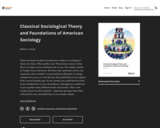
There are a few major themes that come up over and over again during the course of classical sociological theory’s development. All three classical theorists were writing at a time when sociology was a new and emerging discipline. This new discipline was called forth by momentous social changes taking place in European (and American) society during this time period. These changes were related to the rise of capitalism, industrialization, and new political representation for the majority of people (or, at least, a desire for such by many). Calls for socialism emerged as a response to recognition of new social divisions. Each of the three theorists you will read here weighed in on these historical changes, theorizing the contours and dynamics of this new “modern” society.

There is unequivocal evidence that Earth is warming at an unprecedented rate. Human activity is the principal cause.

According to Pierre Bourdieu, cultural capital is the cultural knowledge that serves as the currency that helps us navigate a culture and alters our experiences and the opportunities available to us. This theory focuses on the embodied, objectified and institutionalized states of capital and is significantly important in assisting us in understanding inequality in education and other social structures. Further explanation of cultural capital can be found on page 365 of the Sociology 2e text by OpenStax College.

The ideas people have about health, the languages they use, the health literacy skills they have, and the contexts in which they communicate about health reflect their cultures. Your organization can become more health literate and increase its communication effectiveness when your staff recognizes and bridges cultural differences that may contribute to miscommunication.

With help from some surprising footage, Derek Sivers explains how movements really get started. (Hint: it takes two.)
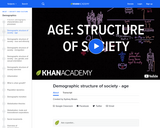
Sociology often looks at different age cohorts. A cohort is simply a group of people, but here we're looking specifically at different age groups or generations, because these people all lived through the same certain events through a certain time that affected their lives similarly.

Discrimination can be defined in two ways: individual and institutional. Individual discrimination refers to the prejudiced behavior of one person, while institutional discrimination refers to the way an organization's rules or policies disadvantage certain groups. Although they are distinct, these two forms of discrimination can be interconnected. Individual discrimination can be reinforced by institutional policies, and vice versa, which leads to a larger, systemic issue. (. Created by James Howick.

Using data from the New Immigrant Survey, we examine the religious beliefs and practices of new legal immigrants to the United States. We find that Christian immigrants are more Catholic, more Orthodox, and less Protestant than American Christians, and that those immigrants who are Protestant are more likely to be evangelical. In addition to being more Catholic and more Orthodox than American Christians, the new immigrants are also paradoxically less Christian, with a fifth reporting some other faith. Detailed analysis of reported church attendance at places of origin and in the United States suggest that immigration is a disruptive event that alienates immigrants from religious practice rather than “theologizing” them. In addition, our models clearly show that people who join congregations in the United States are highly selected and unrepresentative of the broader population of immigrants in any faith. In general, congregational members were more observant both before and after emigration, were more educated, had more cumulative experience in the United States, and were more likely to have children present in the household and be homeowners and therefore yield biased representations of all adherents to any faith. The degree of selectivity and hence bias also varies markedly both by religion and nationality.
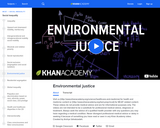
Where we live in society plays a huge role in the environmental benefits and risks that we're exposed to.

Understanding our planet to benefit humankind

In less than two decades, the graying of America will be inescapable: Older adults are projected to outnumber kids for the first time in U.S. history.